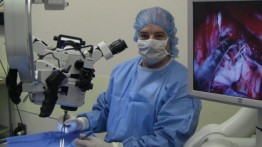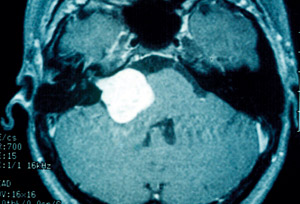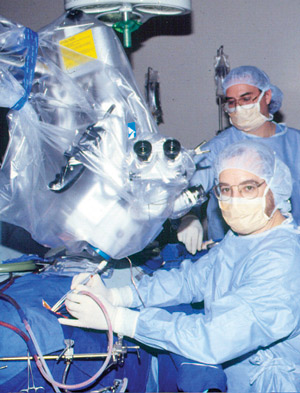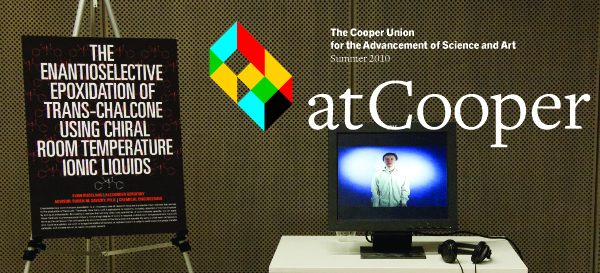Michael Sisti: Good Medicine through Changing Paradigms
POSTED ON: June 1, 2010

Read this article in Russian or Ukrainian
Michael Sisti is drawn to many things about his job, but a love of problem-solving and building human relationships top the list. There’s an allure in the beauty of his subject too.
Sisti is a neurosurgeon whose pragmatism and idealism have often led him down other routes than the traditional and the expected. He’s an articulate man, who talks easily about his life, his speech picking up speed when he touches on topics about which he feels passionate. He is the co-director of The Center for Radiosurgery and James G. McMurtry III, MD Associate Professor in Clinical Neurosurgery at the Columbia University Medical Center. Sisti’s pragmatic side has had a great influence upon his career. Froma very young age, Sisti knew he wanted to be a doctor. But, he also knew he wanted to approach medicine from a different angle than that taken by most doctors. As a student, he had a natural affinity for biology and anatomy, and a fascination with problem-solving. He was interested in how each problem was the unique triangulation of those three things, and therefore saw medicine as necessitating unique solutions. This would lead him down a different path: unlike most doctors, Sisti decided against a liberal arts degree. “Engineering is about taking the basic sciences—whether that’s chemistry, physics or mathematics—and applying them to solve practical problems.Medicine,” he says, “is the same thing. In both cases, the process of applying scientific knowledge to the practical problems of the real world is exactly identical. As a doctor, you use this knowledge to help people with their illnesses. As an engineer, I see how solutions have to be specific not only to the disease, but to the affected person. So, the engineering solution has to be per individual.” For Sisti, a liberal arts degree couldn’t have given him what an engineering degree would.“What I found,” he explains, “was that medicine is the most humanistic of the engineering disciplines.”

In a sense, it’s hardly surprising that Sisti chose engineering.He was born in 1955 into a family of engineers. His father, Charles, was a successful civil engineer, with a specialty in the marine environment, and his uncle, also named Michael, had been a Manhattan Project engineer, helping with the development of the first atomic bomb during World War II. Sisti and his family lived in Brooklyn, until he was six, when the family moved to Tenafly, New Jersey, where his mother, Emily, took a job as a secretary in the public school system. Family is a central part of Sisti’s life, and to this day, he feels that his parents are two of the most important people in his life and their values and ideals have shaped his own: “I was really lucky. They supported me, gave me encouragement and taught me to be a good person.” He also cites being hard-working and wanting to make a difference. “I’ll quote Steve Jobs here,” he laughs. “I’d like to make a dent in the universe.”
Sisti married his high school sweetheart, Elena, right after he graduated Cooper. Elena, a Barnard graduate who has had a 25-year career in banking, has been a pivotal influence as well, having been with him throughout all the important developments in his life. When it came time to apply to university, Sisti knew he wanted to get his engineering degree from Cooper Union. Throughout his childhood, he had heard a great deal about Cooper from his father and uncle, though they themselves were trained at NYU and Pratt, respectively. His father’s boss was a Cooper graduate, and the excellence of the education that Cooper provided for engineers was well recognized. Cooper Union added another value to the foundation that his parents had already provided. “I heard a lot about the quality of the teachers and graduates,” says Sisti, “but I also knew it was tuition-free; in other words, it was freely given knowledge.” Sisti emphatically insists upon the importance of sharing knowledge freely—whether it’s with his patients or his students.
Though not many doctors train as engineers, two other men in Sisti’s year and department at Cooper also went on to become doctors. “One specialty—chemical engineering—produced three very good doctors that year,” says Sisti, “These guys are absolutely brilliant.” Sam Dower went on to specialize in diabetes and endocrinology, and Joel Yarmush became an anaesthesiologist. “In fact,” Sisti says with a laugh, “Joel went to medical school at Columbia. We’ve worked together a few times, when I was the resident participating in the surgery, and he was the anaesthesiologist. So there were times when there were two Cooper Union engineers doing brain surgery!”
Sisti graduated from Cooper Union in 1977, and went on to attend the College of Physicians & Surgeons, Columbia University, graduating in 1981, and did his residency at the Columbia University Neurological Institute of New York. He had decided to become a neurosurgeon because of his love of complexity. “The difficulty of neurosurgery attracted me more than anything else,” he says.He loved that the brain as an organ was so complex, but was also fascinated by how it produces consciousness. “We are our brains,” he states. “Consciousness is a by-product of secretions of the brain. Historically, the brain has been seen as electrical engineering; but the brain is not a computer, it’s much more of a secretory organ. So I’ve always said that the brain secretes the soul.”
 “But, the fact that something so aesthetically beautiful can function so well has always surprised me.”He continues, “The actual anatomy of the brain is beautiful, the color of it, the way it looks. A lot of people don’t realize that the brain is mobile, it throbs with each heartbeat: it’s alive. It has an incredibly complicated, three-dimensional geometry that I think mathematicians would find fascinating.”
“But, the fact that something so aesthetically beautiful can function so well has always surprised me.”He continues, “The actual anatomy of the brain is beautiful, the color of it, the way it looks. A lot of people don’t realize that the brain is mobile, it throbs with each heartbeat: it’s alive. It has an incredibly complicated, three-dimensional geometry that I think mathematicians would find fascinating.”
His training as an engineer gave him a different way of looking at medicine. “I went to a very good medical school,” he explains, “and a lot of my colleagues were very smart and very dedicated, but really didn’t have a practical appreciation of how to translate theoretical knowledge into real-world solutions. The engineering education I got at Cooper was very important in terms of the process of problem-solving I would apply to medicine.” Where his colleagues were thinking inside the medical school box, being an engineer allowed Sisti to think outside that box. Doctors have a way of thinking, a culture, he explains, and it is often hard to break out of the taken-for-granted rules of that culture. Essentially, Sisti was coming from another culture—engineering—and he applied the rules of his culture to the world of medicine.
Neurosurgeons generally had a drill and cut culture, and Sisti was about to change the rules. Upon finishing his residency, he was offered a position at Columbia in 1988, where he has been ever since. “In the 1980s, when I was doing my residency,” Sisti says, “there was the first inkling that computers could possibly play a role in medicine. Yet, computers were anathema in the 1980s to a lot of my colleagues. If you come from my background,” he continues, “you’re interested in solving problems however you can solve them. You don’t have any preconceived notions about what shape those solutions will take or what technology they’ll use. Using computers is intuitive to an engineer; it wasn’t intuitive to most doctors. Back then, using computers in medicine was radical and it was controversial.” It’s different now, he continues, where today’s generation of medical students turn to technology automatically. This generation will link the brain to computers for illnesses like paralysis or Alzheimer’s disease, Sisti believes, and students training today will be using technologies like neural augmentation and bioneural interfaces.
So, back in the late 1980s, it was lucky that Sisti’s mentor, Bennett Stein—the Chairman of the neurosurgery department at the time—was interested in the application of computers in medicine. Because of his engineering background, Sisti was the obvious man for the job of investigating this technology. “Basically, we wanted to use computers to solve the ‘needle in the haystack’ problem—how do we navigate within the brain? It’s a surveying problem.” He pauses briefly. “Call it GPS for the brain.”
At the time, this technology was not commercial, and so Sisti needed to build it from scratch. Stein sent him to speak with the head of Radiation Physics at Columbia, Dr. Howard Amols, who, as it turned out, was a Cooper Union graduate himself (Physics’70). The two men immediately got along. “One of the things I enjoyed the most in my early career,” says Sisti, “was working with Howard.” Dr. Amols remembers that first meeting quite well too. “Mike told me that he wasn’t smart enough to be an engineer, so he decided to become a brain surgeon.” Amols can’t help laughing as he tells this story. “I suspect he may have said that tongue-in-cheek. He’s very modest— since he went to Cooper, I knew he had to be smart.”
 Sisti’s goal was to use computers in the operating room for localization issues, so an operation could be done without cutting the patient open: in other words, he was interested in noninvasive surgery. “Howard could tell me exactly what needed to be done,” Sisti explains, “and because I was an engineer, it was very easy for me to understand the principles.”Together, they developed the first linear accelerator (a machine used to deliver high energy x-rays to radiate tumors) to be used in the tri-state area. “You can train these machines,” Sisti explains, “ to understand the anatomy of the brain, and to outline pathology.” By December of 1989, Sisti and Amols successfully treated their first patient, a first not just at Columbia but in the state of New York. “Today,” Sisti says quietly, “the radiosurgery program here at Columbia is one of the busiest in the country. We went from stone age to space age. We’ve treated well over 3,000 patients, and it all started with Howard and myself.”
Sisti’s goal was to use computers in the operating room for localization issues, so an operation could be done without cutting the patient open: in other words, he was interested in noninvasive surgery. “Howard could tell me exactly what needed to be done,” Sisti explains, “and because I was an engineer, it was very easy for me to understand the principles.”Together, they developed the first linear accelerator (a machine used to deliver high energy x-rays to radiate tumors) to be used in the tri-state area. “You can train these machines,” Sisti explains, “ to understand the anatomy of the brain, and to outline pathology.” By December of 1989, Sisti and Amols successfully treated their first patient, a first not just at Columbia but in the state of New York. “Today,” Sisti says quietly, “the radiosurgery program here at Columbia is one of the busiest in the country. We went from stone age to space age. We’ve treated well over 3,000 patients, and it all started with Howard and myself.”
“It was a wonderful experience,” agrees Amols. “It was a great project, and I think everyone who was involved was really proud of it.” Neurosurgery turned out to be the perfect confluence of Sisti’s pragmatism—approaching medicine as an engineering problem—and his ideals of making a difference and giving knowledge freely to people. “This was my little dent in the universe,” he says. “Not only by bringing this technology to Columbia, but also because I’ve insisted that every neurosurgeon here is trained to do radiosurgery; having more options makes us better surgeons. I’ve also been instrumental in growing the neurosurgery department.When I joined the faculty, there were seven of us. As of this summer, there will be 25 of us. It’s the largest neurosurgery group in the United States and one of the most successful.”
This confluence is also what led him to emphasize the importance of the doctor-patient relationship. Engineering made him approach each patient differently—even if they had the same physical illness. For him, knowledge of a patient’s personality, personal circumstances and values and core beliefs is an essential part of diagnosis. “I'm a neurosurgeon,” he says evenly. “If I really want to know what the disease has done to a person, I need to have some idea of what kind of person they are. Imagine a musician with a tumor involving the nerve of hearing, which has very little capacity for regeneration from surgery or radiation.Managing the treatment of that disease to try to preserve a sense that is at the core of that person’s passion, identity and life is hugely important, and I can’t know that without developing some relationship with the patient. There is no one solution that works equally well for everyone.” The driving passion for Sisti is the intense interactions that he has with people in order to help them with their diseases in the best way possible for them. And it’s what it keeps it exciting. “This is not a career where boredom plays a role!” he exclaims.
This one-to-one approach is also Sisti’s philosophy when it comes to teaching. “In neurosurgery,” he says, “teaching is master to apprentice, so I teach it one-to-one.We’re looking for masters, people who change the paradigm, and that takes time. It takes six to seven years after medical school just to become proficient, and then you need another three to five years to become an expert, not to mention the time you have to put in after that to become a master.” In fact, Sisti has found that in building relationships with his students through teaching and mentoring, through writing papers and doing research together, he also was able to find his future colleagues. Teaching is very important to Sisti. Part of it comes back to Cooper Union. “This knowledge was given freely to me,” he explains, “and I want to give it freely back to someone else.”
Sisti also understands that giving freely impacts the future. “I want the next generation of doctors to have the same advantages that I did, to never have to worry about what it would cost, so that they can just take care of the patient, like I did. I want them to have freedom to practice good medicine.” This means that one of his next challenges in his career will be to think about who will succeed him in his department. “I want to make sure that someone will pick up where I left off and take it to the next level.”
Sisti’s kids like to joke that he’s keeping the tradition of giving knowledge freely through free tuition alive as his two sons are attending Columbia, where Sisti’s status as faculty member means no fees. Alexander, who is 22, is doing neural augmentation research, and 20-year-old Jonathan is training to be an engineer.His daughter, Ariana, is 18 and is in her freshman year at Barnard.
Sisti feels that his career is a direct result of great mentors, a fantastic family, a strong education and good luck. But he does bring up what Louis Pasteur once said: chance favors the prepared mind. Sisti may have been in the right place at the right time, but he was also the right person to take advantage of the opportunities around him and take it to the next level.





